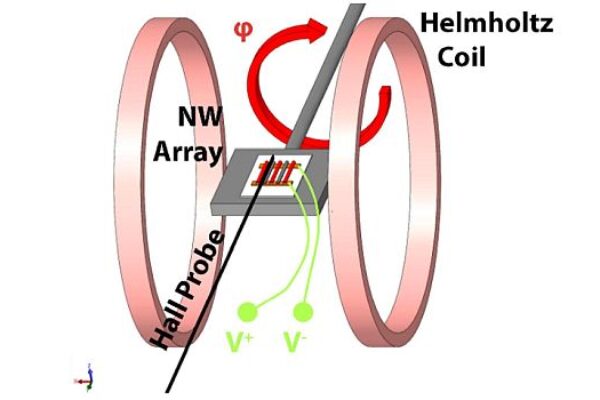
Nanowire magnetic sensor boosts battery life
Created to deal with the problem of battery depletion from powering the increasing number of sensors found on today’s vehicles, the nanowire sensor creates its own energy. Requiring no external electric current to operate, the composite magneto-electric nanowire array sensor is made up of two halves: barium titanate, which exhibits piezoelectric properties, paired with cobalt ferrite, a magnetostrictive material.
In the presence of a magnetic field – such as that present in the steel gears in a car engine – the cobalt ferrite undergoes a shape change, which imparts a strain to the piezoelectric barium titanate, thereby inducing an electrical polarization. By connecting the nanowire array to a data gathering source, the electrical impulses generated by the magneto-electric can be used to sense the engine timing or detect a skid by the wheel speed.
Functional magnetic field sensors, say the researchers, are formed by connecting many nanowires in parallel. The researchers reported that their nanowires showed significantly stronger magneto-electric coefficients (indicating stronger electrical impulses were generated) than traditional magneto-electric material.
These stronger electrical impulses mean that additional improvements to the device could result in even smaller sensors. The fact that the sensors use no external electrical energy source adds to their appeal for use in driver-attended and autonomous electrical vehicles, say the researchers.
The University’s Office of Technology and Licensing has obtained a provisional patent on the technology and has filed for a U.S. utility patent. Semiconductor maker Allegro Microsystems (Manchester, NH) has licensed the patent for the device, citing that the technology highly aligns with their vision of moving the world toward a safer and more sustainable future.
For more, see “Magnetic field sensors using arrays of electrospun magnetoelectric Janus nanowires.”
Related articles:
- NANOMESH MATERIAL BOOSTS FAST-CHARGING BATTERY PERFORMANCE
- SWISS RESEARCHERS BOOST NANOWIRES FOR SOLAR PANELS
- NANOWIRE SUBSTRATE ALLOWS RESEARCHERS TO TUNE INGAN’S RESPONSE FOR FLEXIBLE ENERGY ABSORPTION
 If you enjoyed this article, you will like the following ones: don't miss them by subscribing to :
eeNews on Google News
If you enjoyed this article, you will like the following ones: don't miss them by subscribing to :
eeNews on Google News



